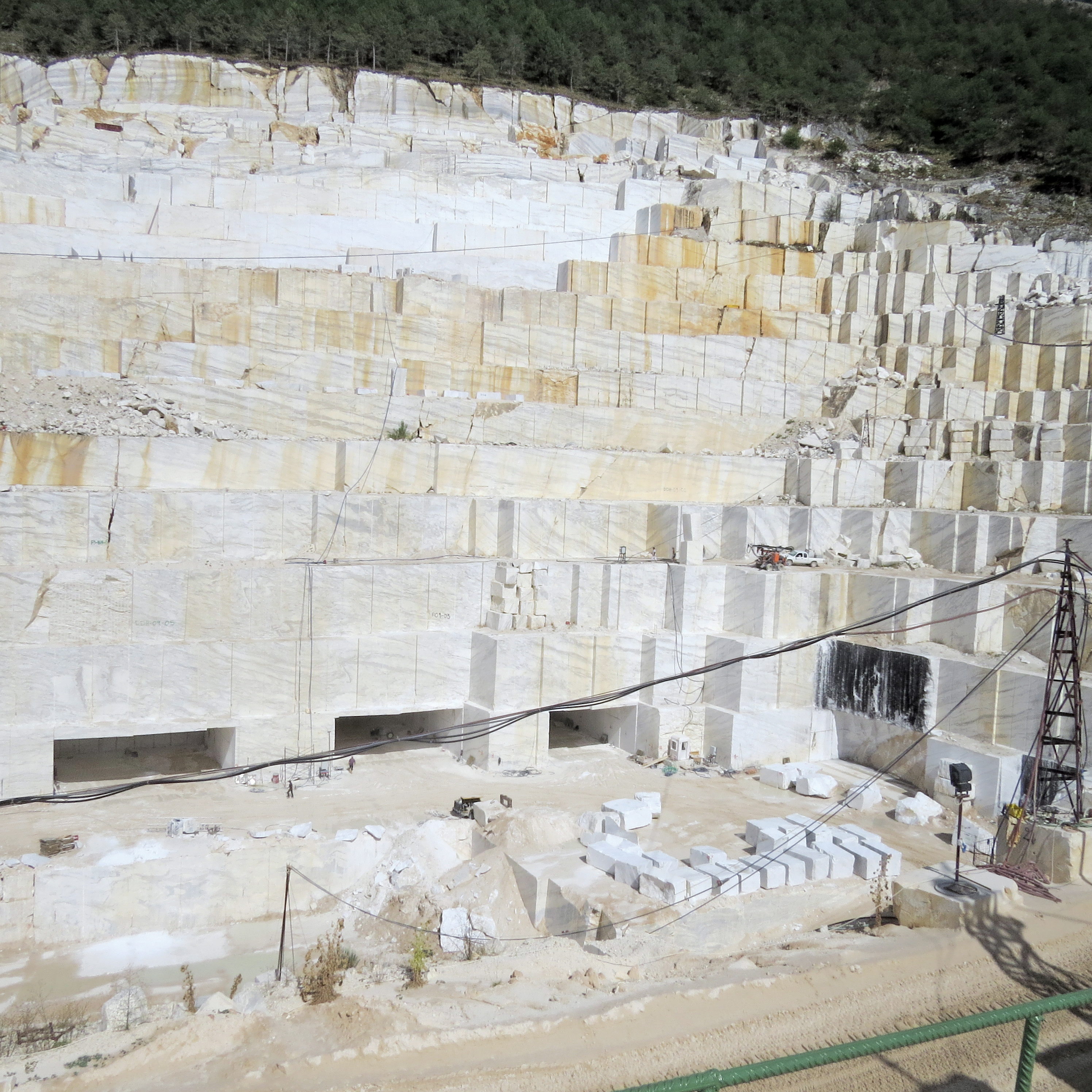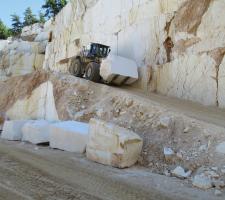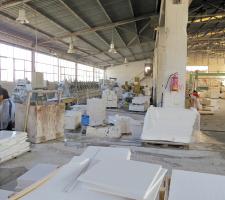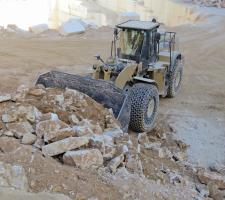
Marble has for centuries been used to build some of the most iconic structures in the world. Patrick Smith reports
Little has changed over the years, or is likely to, as the stone - quarried, cut, shaped and polished - is still the building material of choice for impressive buildings such as the Grand Mosque in Abu Dhabi; the Uzbekistan parliament building and parts of the new Ground Zero structure in New York. In Makkah (Mecca), Saudi Arabia, the holiest city in the religion of Islam, it is not only spectacular but serves a practical purpose: its properties help keep barefooted worshippers cool. There are many types of highly prized marble but none more so than the pure white Thassos marble found on the picturesque Greek island of the same name in the Aegean Sea.
In a country whose economic troubles are well documented, the snow white rock, with no blemishes, is so sought after that demand regularly outstrips supply.
From Thessaloniki, Greece’s second city, it is a two-hour drive east to one of the ports that regularly ferry vehicles and passengers between the mainland and Thassos island 30 minutes away.
All the marble produced at the island’s quarries is also taken out this way and then onto the port at Thessaloniki for worldwide distribution with the top destination being China. However, exports are worldwide with India, UAE, Saudi Arabia, Italy, Spain, Portugal and the USA among other buyers.
While Greece is not the world’s top marble producer (Italy, China, India and Spain are said to be bigger) it does have heavy concentrations of quarries.
The island of Thassos boasts ten marble quarries including that of Haritopoulos SA at Mourgena, while another producer of Thassos marble, the FHL Kiriakidis Group, also has the ground-breaking Volakas marble quarry on the mainland at Nevrokopi Drama where the owner is unveiling a €4.6 million investment plan for the future.
This quarry is some 130km north-west of Thassos and some 170km north-east of Thessaloniki.
While the companies use a variety of equipment to produce marble, they rely heavily on
Although the equipment is covered by customer service agreements (CSA), he is a regular visitor to these and other quarries where Caterpillar equipment is in use to make sure everything is operating well.
Indeed, on a visit to the Haritopoulos quarry he also calls in to see another customer nearby.
“It is important that we make sure everything is operating as it should be as the quarries cannot afford any delays in production,” says Botsifaras who points out that the Haritopoulos quarry invests in new equipment only, because Thassos is a small island some distance from Thessaloniki and he wants maximum uptime.
Caterpillar Vision Link, powered by
Also visiting the Haritopoulus quarry is Peter-Valentin Sauter, Caterpillar Quarry Specialist, EAME Caterpillar Global Construction & Infrastructure Division based in Geneva, Switzerland.
“Block handling is a growth area for companies. If you look at the big picture block handling is comparatively small compared to other market segments but it is an area where we want to further grow,” he says.
The Thassos quarry of Haritopoulos, a third generation family business now run by Nikolaos (Nikos) Haritopoulos and his two sisters Evaggelia, who is in the finance department, and Voula, who runs the sales department. The company employs 55 people.
The business was started as an aggregate quarry in 1958 by the father and grandfather of Nikos, Dimitrios and Nikolaos Haritopoulos, and in 1965, spotting a demand for white Thassos marble, the company entered the marble export business.
That quarry was founded in 1970 by Nikos’s father Dimitrios Haritopoulos (he is now a consultant with the company and on the board of directors), and in 1972 a licence was obtained to exploit white marble over a surface area of 40,000m², while in 1988 the factory for cutting, shaping, polishing and finishing the marble was set up nearby.
Nikos Haritopoulos took over management of the company in 1997, and in 2010 he was granted a licence for an extension of an additional 24,000m² while in 2012 the company purchased a neighbouring quarry with a surface area of 21,000m².
“The first export of Thassos marble from the quarry was in 1965. That was to Germany but they did not like the product so they wanted to return it: that is before it became famous. Eventually the buyer said to leave it there because transport costs were expensive,” says Nikos, who is always looking at expansion opportunities.
Now 100% of the marble produced is exported to China, India, the UAE, Saudi Arabia, Italy, Spain, Portugal and the USA.
This is either achieved by blocks being directly loaded into containers and send via Thessaloniki to China and Turkey for processing, or through Greek companies processing marble blocks, and then exporting the final products.
Annual production of saleable material at the quarry, which operates one shift, five days a week all-year round, is 55,000tonnes.
“We take the overburden out but only 30% of the material that is taken out is sold. The other 70% of material is debris,” says Nikos.
“Of this 70%, some 50% is sold to local contractors for projects such as road and building construction in Thassos. The other 50% is exported by another marble company and has a wide range of uses such as medicine and paper production.”
The debris material is transported by a Caterpillar 980K BH to the crusher and following crushing and screening, the material is loaded onto trucks to be transported to a stockpile with this material being used for road construction, filling material and tiles.
Overburden removal is carried out using Caterpillar 336D, 336E, 330B and 345B hydraulic excavators with quick couplers, buckets and rippers.
To remove the blocks of marble rock at the face for processing or export, first a series of holes are drilled using an Italian Benetti drilling machine. The machine can drill in vertical, horizontal or inclined directions, and is designed to make intersecting holes through which a diamond wire can be passed to saw through the stone in marble or granite quarries.
“We drill 7m-long holes, two horizontal and one vertical and these connect with each other. A cable with diamond tips is put into the holes and the marble is cut,” says Nikos.
“The big marble blocks that fall from the face are 3m wide, 3m deep and 6m high and can weigh up to 150tonnes.
“A metal device is pushed into the crack to widen the gap under high water pressure to 40mm and a Caterpillar hydraulic excavator with a ripper is used to bring down the marble block from the face.
“We have a big fleet of Caterpillar equipment and this is used for removing, splitting and handling the blocks.
“All the excavators have quick couplers and rock buckets and these are used when the debris is taken out. Some excavators that take blocks out also remove debris with buckets.”
The process of cutting and removing the block can take up to five days with the longest process being the cutting with the diamond cable, which is done at some 9m²/hour. One set of 50m cables, which are manufactured in Italy, last for about 2,000m².
When a block is down it is cut into smaller blocks measuring 1.5m wide, 1.5m deep and 3m long, weighing 20tonnes, and these are handled by block handler loaders, also from Caterpillar, including the 980GII BH, 980H BH, 980K BH and 988FII.
The blocks are transported with the 980K BH to the storage area ready for sale or processing in the processing plant.
For extraction from the floor of the quarry, opening a new level, a chainsaw is used for vertical cuts into the floor and a metal device is placed in the crack, then actuated with high pressure water to loosen the block at the bottom. A Caterpillar 980K BH is used to lift the block out of the floor.
At the processing plant, sawing and polishing machines are used.
Raw blocks are cut into standard sized blocks for further processing and these are cut into vertical layers.
“For blocks, not finished products, the main markets are China and India. They have high taxes for processed marble. It is better to import it as a block and process it in China or India,” says Nikos.
“Some 80% of the exports go through the port of Thessaloniki in containers. The rest goes by truck.”
Nikos says that at present the biggest project involving Thassos white marble is in Makkah, Saudi Arabia.
“In Makkah in the area where they pray they put the pure white marble on the floor because it reflects heat and is comfortable for those praying barefoot.”
FHL Kiriakidis
Ilias Kiriakidis, owner of the FHL Kiriakidis Group, has been in the quarry business for 33 years.
He started after leaving the Greek merchant navy where he gained his master’s degree as a captain.
Founded in 1992 as FHL I. Kiriakidis Manufacturing and Trading Marbles & Granites, the operation now boasts one quarry in Thassos at Kavala and one quarry in Nevrokopi Drama while in 1999 the group bought the 200,000m² quarry in Volakas Drama. The group also owns three marble and granite processing factories where it handles Thassos white marble along with others including Sivec White and Volakas, which has a grey stripe running through it.
“The extraction at Volakas is about 500,000tonnes/year of which 70% is waste and 30% or 120,000tonnes is saleable,” says Ilias Kiriakidis. At this rate of extraction he estimates there is some 70 years life left at the quarry.
“A big part of the waste is crushed and used for dry mortar. We have a dry mortar plant not far from here.”
However, one of the most interesting developments at the quarry is the introduction of underground quarrying which it is planned to expand.
Wheeled Excavator
1 x Caterpillar M322DExcavator
1 x Caterpillar 330B
2 x Caterpillar 336D
1 x Caterpillar 336E
1 x Caterpillar 345BWheeled Loaders
1 x Caterpillar 950G
1 x Caterpillar 950H
1 x Caterpillar 980GII BH
1 x Caterpillar 980H BH
1 x Caterpillar 980K BH
1 x Caterpillar 988FIITracked Loader
2 x Caterpillar 963C
Drilling Equipment
1 x Benetti drill rigAll Kiriakidis’s quarries started as open pit operations, but in the Volakas quarry material is now being extracted also using the underground process. Based on the positive experience to date, Kiriakidis plans to apply the underground process to his other quarries.
A special licence was required for the underground operation which is run with three underground engineers on site and using two special Fantini GU70-R/XC saws from the Italian manufacturer. It offers saw machines for the extraction of natural stone
“It is a very impressive quarry,” says Kiriakidis.
“Using the underground method we saw tunnels into the rock and these can go as far back as 200m to our boundary. With the change to the underground operation the quality/waste ratio of 30/70 could get converted to a quality/waste ratio of 70/30. We have reversed it. I think we are only the second quarry in Greece to use this method.
“Currently we are working on five tunnels but it is likely this will be increased to seven tunnels. We can leave workable ceilings.”
The Fantini circular saws have diamond teeth and these cut vertically and horizontally before high pressure water is used to break the block away. A Caterpillar 980H wheel loader is used to pull the block out. It is one of a fleet of Caterpillar equipment supplied by Eltrak to FHL I. Kiriakidis that also includes two 769C, one 769D and two 771D dump trucks; seven 980H BH, two 988B and one 988F wheel loaders, and one 235C and six 345D hydraulic excavators. All have CSA service contracts and are equipped with Vision Link.
According to Kiriakidis, with the underground operation process both operating costs and safety could be significantly improved.
Some 90% of the marble blocks produced at Volakas are exported to China using 5,500 container loads each year, while the remaining 10% of the production is exported mainly to Italy, Taiwan and some to Indonesia.
In China, marble is used mainly for office buildings and apartments, demanding marble at high volumes and material with high consistency (especially important for office buildings).
While China accounts for approximately one-third of global stone demand, India, Turkmenistan and Uzbekistan are becoming important import countries for marble, especially for the white marble from Thassos. This has a heat reflection factor of 85% (the highest known factor in the industry) and is in demand for projects in Jedda, Medina and Mecca, Saudia Arabia. It is also being used for a current major mosque project in Miami, Florida, USA.
“Marble is a luxury item but the marble industry is still growing because new players are coming into the game,” says Kiriakidis.











